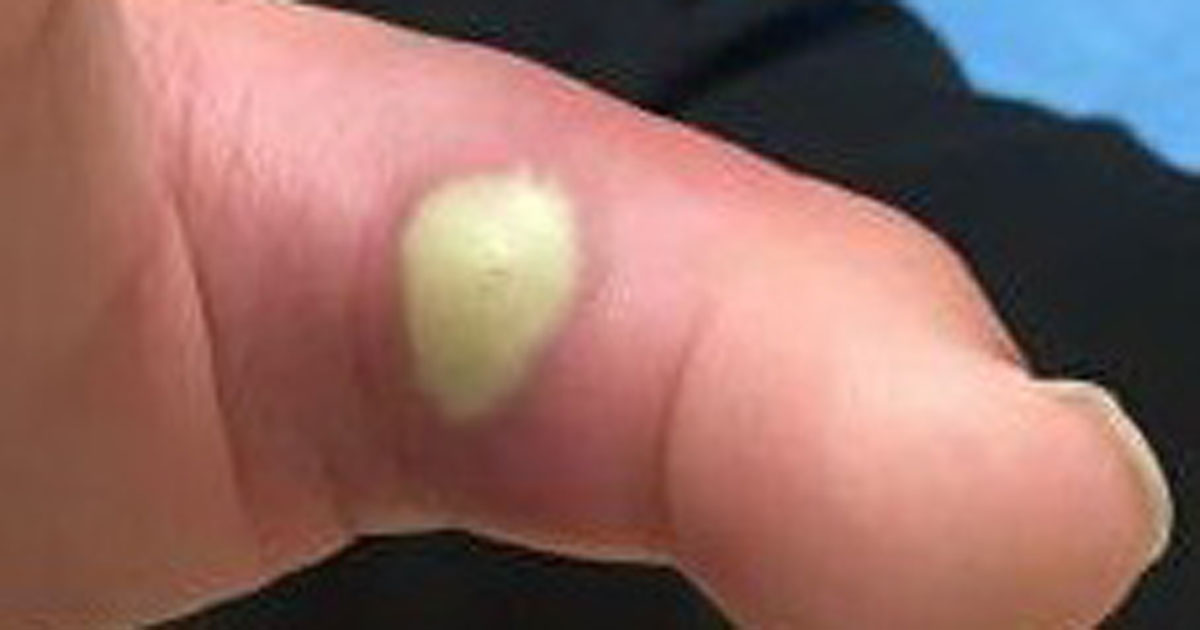Boy presents with lesion on thumb; sometimes, there is no obvious answer
Click Here to Manage Email Alerts
A 12-year-old boy presents to his primary care provider with a painful lesion on the medial aspect of his right proximal thumb.
Significant past medical history includes the diagnosis of basal cell nevus syndrome in early childhood — a rare genetic disorder that can be inherited or spontaneous and may result in the development of basal cell carcinomas; brain lesions that may be benign or malignant (medulloblastoma); and benign cystic lesions, predominately about the face and mandible (Figure 1) but can also be seen virtually anywhere. There is also an association with cutaneous pits on the hands and feet. However, there is no associated immunodeficiency or increased infection risk.

A benign cystic lesion related to this diagnosis was noted in the same location of the right thumb about 2 years earlier. However, 4 days ago, it began feeling a bit painful and more prominent and slightly erythematous, with what appeared to be a central pit that was likely present before the lesion formed (Figure 2). An attempt at needle drainage was made without any material being obtained, and he was given a prescription for amoxicillin-clavulanate to take orally. However, he returned 2 days later with progression to an abscess-like lesion, with a yellowish central head (Figure 3) and circumferential erythema surrounding the proximal thumb (Figure 4). A plain radiograph revealed soft tissue swelling and normal-appearing underlying bone (Figure 5), and he was admitted for surgical drainage and initiation of antimicrobial agents.
Exam reveals normal vital signs and an alert, oriented and healthy-appearing 12-year-old child with the lesion on the right thumb as described earlier. Incision and drainage revealed yellowish pus with gram-negative rods present and with culture pending.

What’s your diagnosis: Which empiric antibiotic(s) would you chose?
A. Ampicillin-sulbactam
B. Ceftriaxone
C. Trimethoprim-sulfamethoxazole
D. Vancomycin plus ceftazidime

MY answer and discussion:
Trimethoprim-sulfamethoxazole, or TMP-SMX (choice C), would be the best answer. Since the patient may have “failed” amoxicillin-clavulanate, I might not pick ampicillin-sulbactam. However, a walled-off abscess is not likely going to respond to anything in 2 to 4 days. Additionally, considering the Gram stain showed gram-negative rods, I would not add vancomycin. Ceftriaxone has fairly good gram-negative coverage but would normally not be considered a choice for cutaneous abscesses, with Staphylococcus aureus high on the list. However, with the Gram stain results, I would not argue with using ceftriaxone pending culture and sensitivities. The same could be said for ceftazidime, a fourth-generation cephalosporin with fairly reliable gram-negative antimicrobial activity, including anti-Pseudomonas activity. However, since this organism would be very low on the list of possible causes, ceftazidime would not be needed in the immune-competent patient. TMP-SMX may have an advantage of being active against both gram-negative organisms as well as S. aureus. Also, considering that the patient was generally well, and that drainage alone may be curative, one could opt for a same-day surgical drainage and wait for culture and sensitivity results before continuing antibiotics. But, considering the patient’s rare genetic syndrome, it was felt prudent to get rapid control of the infection and observe him for a couple of days before discharging home. When the drain was pulled, the patient was discharged on oral TMP-SMX pending the culture results, which were not available for several more days. The organism was identified as Neisseria elongata subspecies nitroreducens, and was indeed sensitive to TMP-SMX, as well as most other gram-negative antimicrobials, except for ceftriaxone and meropenem.

Neisseria elongata subspecies nitroreducens is considered part of the normal flora of the oral cavity and upper respiratory tract and has been reported to rarely cause endocarditis in adults. I could not find any reports in children, but there are many culture-negative endocarditis cases, among which there could be some cases caused by this organism. For further reading on this organism, I might recommend a study by Osuka and colleagues from Japan, which reviews the microbiology of the organism and reports on 17 adult cases of endocarditis.

Even though the organism can access the bloodstream, like all oral bacteria from time to time, that route of infection in this case is highly unlikely. The route the organism likely took was via the overlying cutaneous pit. Many children have cutaneous pits that occasionally get infected, usually with S. aureus, but some, such as preauricular pits (Figure 6), where the depth of the pit may be unknown, and in a special location (head and neck area about the ear), it may be prudent to be more aggressive with empiric therapy by also covering for gram-negative organisms, such as Pseudomonas aeruginosa as well as S. aureus with ceftazidime, pending culture results.
Many children have genetic disorders, some of which may be accompanied by increased susceptibility to infections, and if so, management should take that into account, with more aggressive empiric therapy. However, where there is no concern for immune deficiency, even in unusual cases such as this, the approach to a cutaneous abscess can be the same as any other patient.

Columnist comments
As we exit another year dominated by the pandemic and its many effects on our day-to-day lives, I would continue to urge you all to get immunized against COVID-19, and if not done yet, get your annual influenza immunization as well. It is good for you, your family and your patients. I wish you all a happy and healthy 2022.
Reference:
For more information:
Brien is a member of the Infectious Diseases in Children and Infectious Disease News Editorial Boards, and an adjunct professor of pediatric infectious diseases at McLane Children's Hospital, Baylor Scott & White Health, in Temple, Texas. He can be reached at jhbrien@aol.com.
